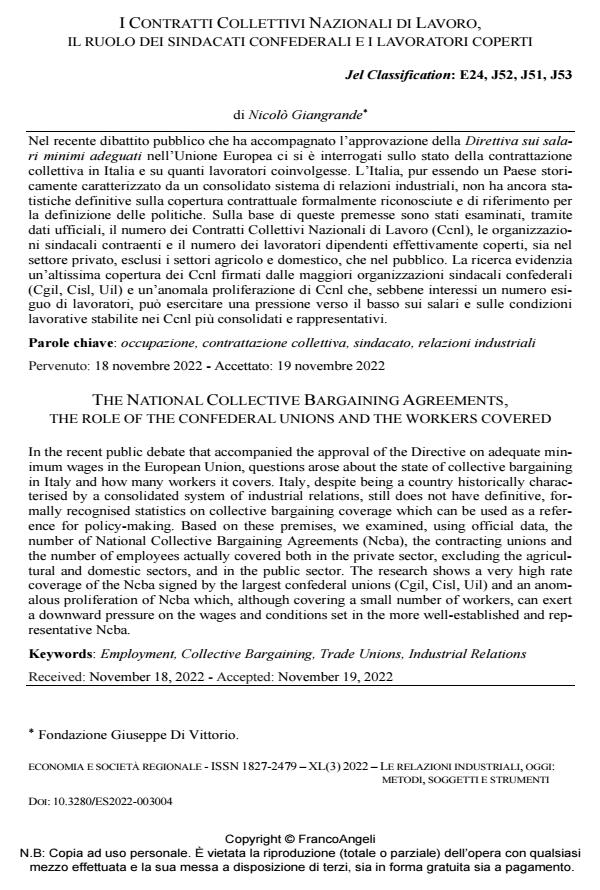The national collective bargaining agreements, the role of the confederal unions and the workers covered
Journal title ECONOMIA E SOCIETÀ REGIONALE
Author/s Nicolò Giangrande
Publishing Year 2022 Issue 2022/3 Language Italian
Pages 10 P. 33-42 File size 335 KB
DOI 10.3280/ES2022-003004
DOI is like a bar code for intellectual property: to have more infomation
click here
Below, you can see the article first page
If you want to buy this article in PDF format, you can do it, following the instructions to buy download credits

FrancoAngeli is member of Publishers International Linking Association, Inc (PILA), a not-for-profit association which run the CrossRef service enabling links to and from online scholarly content.
In the recent public debate that accompanied the approval of the Directive on adequate mini-mum wages in the European Union, questions arose about the state of collective bargaining in Italy and how many workers it covers. Italy, despite being a country historically characterised by a consolidated system of industrial relations, still does not have definitive, formally recog-nised statistics on collective bargaining coverage which can be used as a reference for policy-making. Based on these premises, we examined, using official data, the number of National Collective Bargaining Agreements (Ncba), the contracting unions and the number of employ-ees actually covered both in the private sector, excluding the agricultural and domestic sectors, and in the public sector. The research shows a very high rate coverage of the Ncba signed by the largest confederal unions (Cgil, Cisl, Uil) and an anomalous proliferation of Ncba which, although covering a small number of workers, can exert a downward pressure on the wages and conditions set in the more well-established and representative Ncba.
Keywords: Employment, Collective Bargaining, Trade Unions, Industrial Relations
Jel codes: E24, J52, J51, J53
- Aran (2022a). Occupati nella Pubblica Amministrazione per tipologia di rapporto di lavoro (serie 2001-2019) -- <https://bit.ly/3Ku6UaS>.
- Aran (2022b). Occupati nella Pubblica Amministrazione per categoria di personale (anno 2019) -- <https://bit.ly/3o0fExN>.
- Birindelli L. (2019). Retribuzioni e mercato del lavoro: l’Italia a confronto con le maggiori economie dell’Eurozona. Fondazione Di Vittorio, marzo -- <https://bit.ly/3K6wKl2>.
- Cnel (2017). Le Forze Sociali rappresentate al Cnel nella X Consiliatura -- <https://bit.ly/3vvOK3h>.
- Cnel (2022a). 14° Report periodico dei Ccnl vigenti depositati nell’Archivio CNEL. 31 dicembre 2021 -- <https://bit.ly/3MF6zDK>.
- Cnel (2022b). Archivio Nazionale dei contratti collettivi di lavoro. 1° aprile -- <https://bit.ly/3Esu1l5>.
- Giangrande N. (2021a). Political Economy of Contemporary Italy. The Economic Crisis and State Intervention. London: Routledge. DOI: 10.4324/9781003089322.
- Giangrande N. (2021b). La precarietà occupazionale e il disagio salariale in Italia. Le conseguenze della pandemia sull’occupazione e sui salari. Fondazione Di Vittorio, maggio, 2 -- <https://bit.ly/3tcDTKz>.
- Giangrande N. (2022). La questione salariale e occupazionale in Italia. Un contributo alla discussione sul lavoro povero. Quaderni di Rassegna Sindacale, 1: 15-26 -- <https://bit.ly/3S1QA5l>.
- Inapp (2021). Nota per audizione presso XIV Commissione del Senato della Repubblica. Roma. 11 gennaio -- <https://bit.ly/3FRnzU7>.
- Istat (2020). Esame delle proposte di legge A.C. 707 e A.C. 788 in materia di rappresentanza sindacale. Roma, 29 gennaio -- <https://bit.ly/3OmJMhH>.
- Istat (2021). L’economia non osservata nei Conti Nazionali (anni 2016-2019). 18 ottobre -- <https://bit.ly/36TUBHe>.
- Istat (2022). Contratti collettivi e retribuzioni contrattuali (4 trimestre 2021). 31 gennaio -- <https://bit.ly/3OCpjWt>.
- Leonardi S., Faioli M., Bologna S., a cura di (icp). Il dumping contrattuale nel Terziario. Indagine comparativa sui contratti nazionali del Commercio, Turismo e Servizi. Fondazione Di Vittorio.
- Oecd, Aias (2021). Oecd/Aias Ictwss Database. Note on definitions, measurement and sources. Oecd -- <https://bit.ly/3vAYBVk>.
- Venturi L. (2021). Concorrenza al ribasso tra contratti collettivi. Menabò di Etica ed Economia. 30 giugno -- <https://bit.ly/3v65LSz>.
- Venturi L., Ambroso R., Biagiotti M., Tomaro S. (2021). L’archivio nazionale dei contratti collettivi di lavoro. Evidenze aggiornate a fine 2021. In: XXIII Rapporto Mercato del Lavoro e Contrattazione Collettiva 2021. Cnel: 371-383 -- <https://bit.ly/3OhnaPX>.
Nicolò Giangrande, I contratti collettivi nazionali di lavoro, il ruolo dei sindacati confederali e i lavoratori coperti in "ECONOMIA E SOCIETÀ REGIONALE " 3/2022, pp 33-42, DOI: 10.3280/ES2022-003004